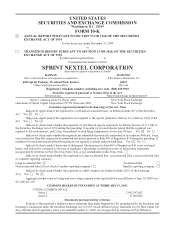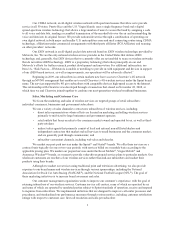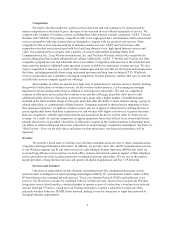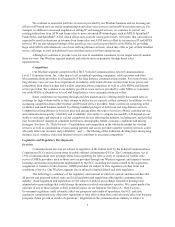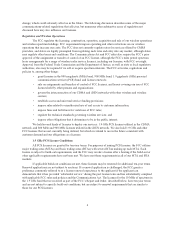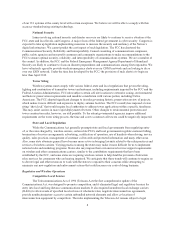Sprint - Nextel 2008 Annual Report Download - page 9
Download and view the complete annual report
Please find page 9 of the 2008 Sprint - Nextel annual report below. You can navigate through the pages in the report by either clicking on the pages listed below, or by using the keyword search tool below to find specific information within the annual report.800 MHz and 900 MHz License Conditions
We hold licenses for channels in the 800 MHz and 900 MHz bands that are used to deploy our iDEN
services. Because spectrum in these bands originally was licensed in small groups of channels, we hold
thousands of these licenses, which together allow us to provide coverage across much of the continental United
States. Our 800 MHz and 900 MHz licenses are subject to requirements that we meet population coverage
benchmarks tied to the initial license grant dates. To date, we have met all of these construction requirements
applicable to these licenses, except in the case of licenses that are not material to our business. Our 800 MHz and
900 MHz licenses have ten-year terms, at the end of which each license is subject to renewal requirements that
are similar to those for our 1.9 GHz licenses.
Spectrum Reconfiguration Obligations
In 2004, the FCC adopted a Report and Order that included new rules regarding interference in the 800
MHz band and a comprehensive plan to reconfigure the 800 MHz band. The Report and Order provides for the
exchange of a portion of our 800 MHz FCC spectrum licenses, and requires us to fund the cost incurred by public
safety systems and other incumbent licensees to reconfigure the 800 MHz spectrum band. In addition, we
received licenses for 10 MHz of nationwide spectrum in the 1.9 GHz band; however, we are required to relocate
and reimburse the incumbent licensees in this band for their costs of relocation to another band designated by the
FCC.
The minimum cash obligation is approximately $2.8 billion under the Report and Order. We are,
however, obligated to pay the full amount of the costs relating to the reconfiguration plan, even if those costs
exceed $2.8 billion. As required under the terms of the Report and Order, a letter of credit has been secured to
provide assurance that funds will be available to pay the relocation costs of the incumbent users of the 800 MHz
spectrum. These relocation costs are reviewed periodically based on actual costs incurred. As a result of these
reviews, our letter of credit was reduced from $2.0 billion to $1.7 billion in 2009 as approved by the FCC.
Completion of the 800 MHz band reconfiguration was initially required by June 26, 2008; however, the
FCC has issued a significant number of waivers to 800 MHz licensees giving them additional time to complete
their band reconfigurations, which may delay access to some of our 800 MHz replacement spectrum. Based on
progress to date, a significant number of additional extension requests have been filed and more are expected.
Under an October 2008 FCC Order, we may be required, on March 31, 2010, to relinquish some of our 800 MHz
spectrum on a region-by-region basis prior to receiving 800 MHz replacement spectrum. On January 27, 2010,
we asked the FCC to waive the requirement in certain regions where most public safety agencies have not yet
vacated our replacement channels. This request is pending before the FCC. The Report and Order also contained
an exception with respect to markets that border Mexico and Canada. The exception with respect to markets that
border Canada was clarified on May 9, 2008 when the FCC issued the Canadian border plans to include a
30-month deadline for completion.
New Spectrum Opportunities and Spectrum Auctions
Several FCC proceedings and initiatives are underway that may affect the availability of spectrum used
or useful in the provision of commercial wireless services, which may allow new competitors to enter the
wireless market. We cannot predict when or whether the FCC will conduct any spectrum auctions or if it will
release additional spectrum that might be useful to wireless carriers, including us, in the future.
911 Services
Pursuant to FCC rules, CMRS providers, including us, are required to provide enhanced 911 (E911)
services in a two-tiered manner. Specifically, wireless carriers are required to transmit to a requesting public
safety answering point (PSAP) both the 911 caller’s telephone number and (a) the location of the cell site from
which the call is being made, or (b) the location of the customer’s handset using latitude and longitude,
depending upon the capability of the PSAP. Implementation of E911 service must be completed within six
months of a PSAP request for service in its area, or longer, based on the agreement between the individual PSAP
and carrier. As a part of the FCC’s approval of the Clearwire transaction, we committed to measure the accuracy
7

